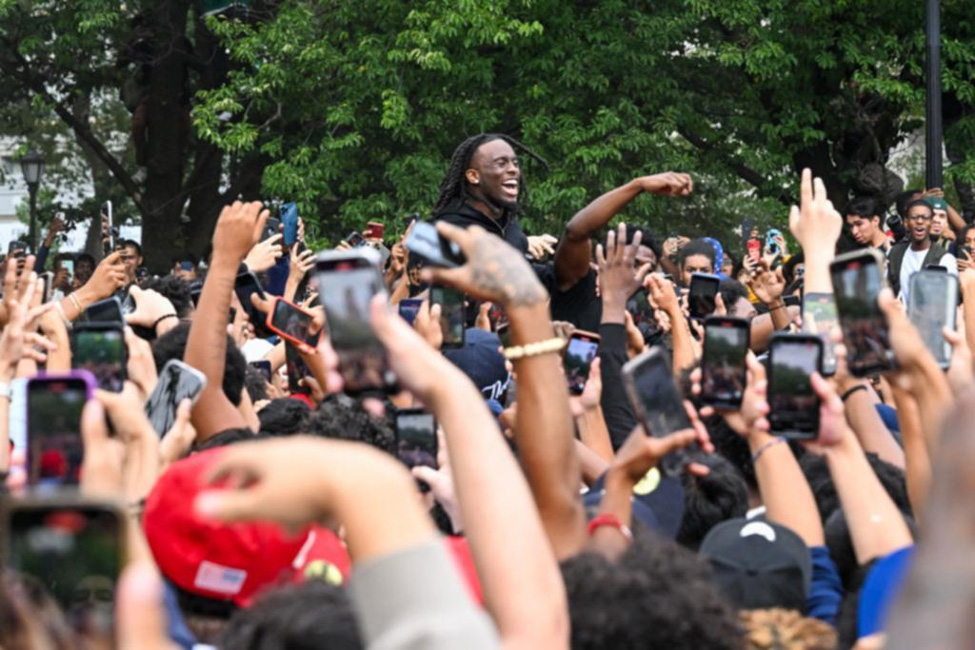It was a regular summer day on August 4th when Kai Cenat, a social media powerhouse with over six million loyalists on Twitch and an impressive YouTube subscriber count of four million, decided to surprise his fans. His plan was simple: head to Union Square, New York City, and say he was going to generously distribute Sony PlayStations and various electronic devices. Little did he know that this simple act of generosity would morph into a media frenzy.
As thousands of eager young enthusiasts thronged Union Square, the atmosphere thickened. Amidst the euphoria, fireworks lit up, not in the sky, but within the crowd. The thrill quickly devolved into chaos. A scene that was meant to be one of celebration and goodwill shifted to an uncontrollable riot. The result? 66 arrests – the majority being minors, and Kai Cenat found himself in the eye of a storm, slapped with accusations of inciting a riot and related charges.
Protect Your Personal Brand: Always Stay Ahead of the Narrative
The media, as we know it, swung into action quickly. The incident was not just local news anymore; it reverberated across national channels, drawing widespread attention. But in this coverage, one underlying narrative became glaringly evident. There’s a discomforting reality to face: A 21-year-old African American male, gathering thousands of his contemporaries, inevitably pushes certain societal buttons. The skepticism, alarm, and watchfulness that such assemblies receive, especially from governmental and local law enforcement units, speak of a deeper issue. An issue that begs the question of racial bias and societal double standards.
Comparatively, history has shown us varying reactions to crowd incitements. Take the controversial episode where former president Donald Trump reportedly nudged his followers to assert dominance over the Capital, stunting the wheels of democracy. He remains untouched by the charge of inciting a riot, using a “free speech” defense, thereby casting a shadow over the alleged fairness of our system. It’s a tactic that does not always work. Especially for people who do not have the money to mount long, expensive legal battles.
In the days that followed the Union Square incident, the pressure on Kai to explain his side mounted. And he did. Opting to use Twitch – a platform he doesn’t technically “own” – he broke his silence, condemning the unrest. But here’s the catch: Kai acted independently, without using a spokesperson, a PR expert, or a publicist. This is counter to, Branding 101 advice: Always stay ahead of the narrative.
When the media senses an opportunity, they are relentless. The story can easily be twisted, painting you in hues far removed from reality. A publicist or PR firm isn’t just about managing an image; they are about damage control, disseminating your truth, and ensuring your voice isn’t lost in the cacophony of sensationalism. They liaise with media outlets, they craft the narrative, and most importantly, they shield you from direct onslaughts.
However, a singular incident, no matter how magnified, cannot define a brand – especially one as established as Kai’s. While this episode might have been a jolt, it’s also a learning curve. It underscores the influence and reach Kai commands. His voice isn’t just a voice; it’s a power, an asset, something that holds tangible value. It’s unclear if Kai has a team providing advice on how to manage his brand but hopefully, they learn from this incident.
Recognizing this the value of a positive brand image is vital. It’s the cornerstone of a brand’s DNA. In today’s digital age, where platforms are quick to capitalize on popular content, creators like Kai must be wary. Handing over intellectual property and using negative publicity tactics can often mean surrendering your value, allowing competing platforms to monetize and reap colossal profits at your brand’s expense. The antidote? Building a robust team, seasoned in personal branding AND damage control, with a keen understanding of preserving and enhancing a brand’s essence. Alternatively, you should find advisers who can act as mentors to help you until you have the means and are able to build a team.
How To Build a Streaming Influencer Brand
YouTube and Twitch have revolutionized the way influencers build a following and monetize their content. Both platforms offer unique opportunities for content creators to connect with audiences and generate income.
YouTube influencers typically start by creating engaging and high-quality videos on topics they are passionate about, whether it’s gaming, beauty, tech, cooking, or any other niche. Consistency is key, as uploading regular content helps maintain audience interest and attract new subscribers. Collaborations with other creators and leveraging trending topics can also help boost visibility.
To make money on YouTube, influencers have several options. The YouTube Partner Program allows creators to earn revenue through ads displayed on their videos. Additionally, they can engage in brand partnerships, where companies pay for sponsored content or product placements. Merchandise sales, channel memberships, and fan donations through features like Super Chat further contribute to their earnings.
On the other hand, Twitch influencers focus on live streaming, providing real-time interaction with their audiences. They often excel in gaming, but other niches like art, music, and even “Just Chatting” have gained popularity. Consistent streaming schedules and engaging with viewers in the chat are crucial for building a loyal following. Interactivity sets Twitch apart, allowing creators to directly interact with fans and create a sense of community.
Twitch streamers generate income primarily through subscriber revenue and donations from viewers using features like Bits and subscriptions. Ad revenue and brand partnerships also play a role. Twitch’s affiliate and partner programs offer creators additional ways to earn, while the platform’s emphasis on direct support from fans through tips and virtual items fosters a strong sense of fan engagement.
In both cases, building a following requires dedication, authenticity, and engaging content. Success often comes from finding a unique voice, establishing a personal brand, and adapting to changes in audience preferences and platform algorithms. The combination of content creation, community engagement, and diverse monetization strategies allows YouTube and Twitch influencers to turn their passion into a sustainable career.
In the grand tapestry of Kai Cenat’s journey, the Union Square incident may only be a mere blip. It’s a testament to his influence and a lesson in brand management. As he evolves, one can only hope that he continues to recognize his worth, ensuring that his brand not only survives but thrives, resonating with authenticity and purpose.



